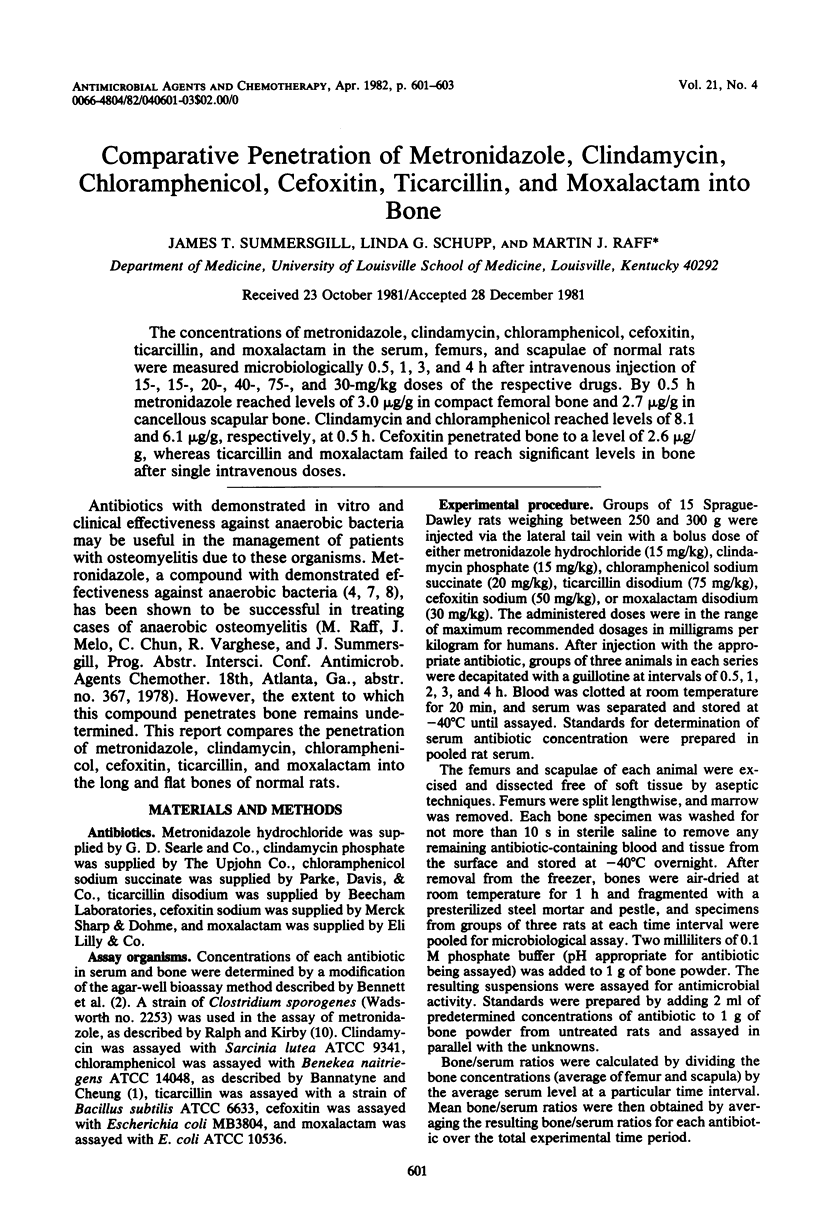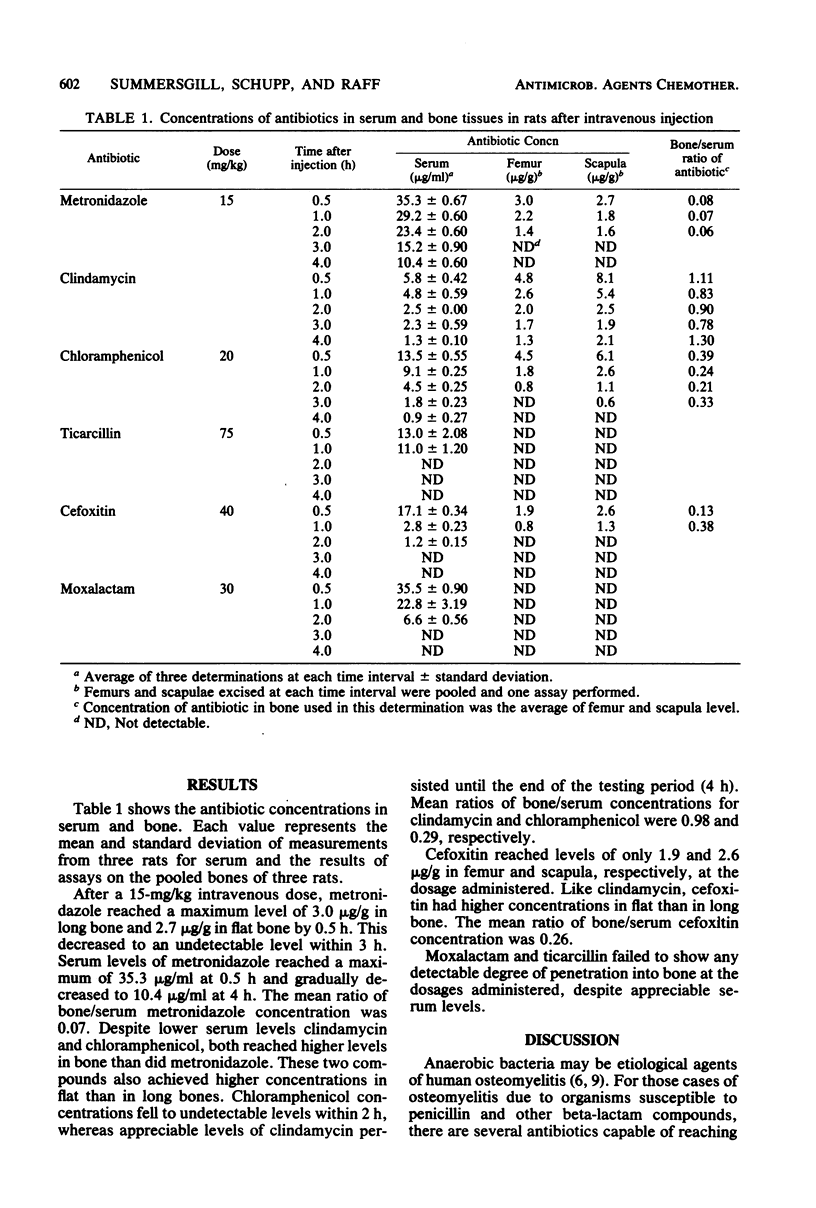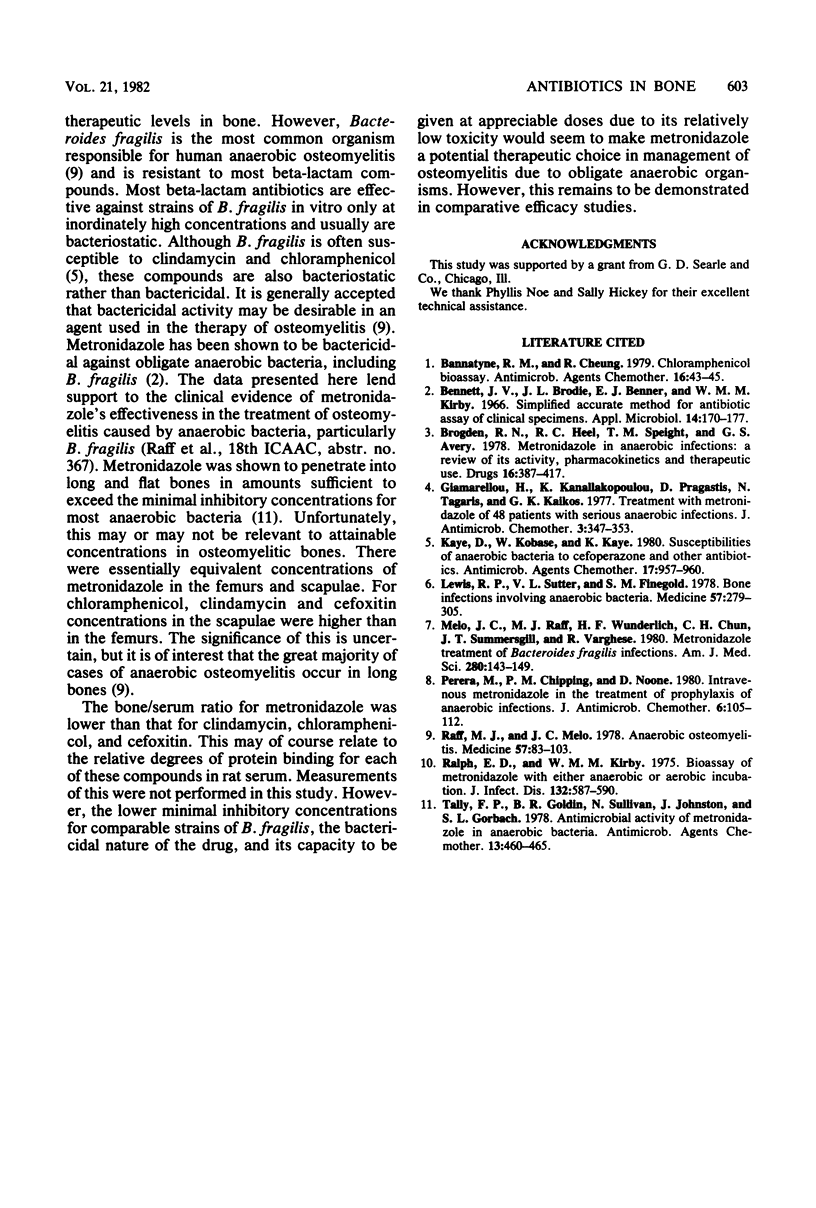Abstract
The concentrations of metronidazole, clindamycin, chloramphenicol, cefoxitin, ticarcillin, and moxalactam in the serum, femurs, and scapulae of normal rats were measured microbiologically 0.5, 1, 1, and 4 h after intravenous injection of 15-, 15-, 20-, 40-, 75-, and 30-mg/kg doses of the respective drugs. By 0.5 h metronidazole reached levels of 3.0 micrograms/g in compact femoral bone and 2.7 micrograms/g in cancellous scapular bone. Clindamycin and chloramphenicol reached levels of 8.1 and 6.1 micrograms/g, respectively, at 0.5 h. Cefoxitin penetrated bone to a level of 2.6 micrograms/g, whereas ticarcillin and moxalactam failed to reach significant levels in bone after single intravenous doses.
Full text
PDF


Selected References
These references are in PubMed. This may not be the complete list of references from this article.
- Bannatyne R. M., Cheung R. Chloramphenicol bioassay. Antimicrob Agents Chemother. 1979 Jul;16(1):43–45. doi: 10.1128/aac.16.1.43. [DOI] [PMC free article] [PubMed] [Google Scholar]
- Bennett J. V., Brodie J. L., Benner E. J., Kirby W. M. Simplified, accurate method for antibiotic assay of clinical specimens. Appl Microbiol. 1966 Mar;14(2):170–177. doi: 10.1128/am.14.2.170-177.1966. [DOI] [PMC free article] [PubMed] [Google Scholar]
- Brogden R. N., Heel R. C., Speight T. M., Avery G. S. Metronidazole in anaerobic infections: a review of its activity, pharmacokinetics and therapeutic use. Drugs. 1978 Nov;16(5):387–417. doi: 10.2165/00003495-197816050-00002. [DOI] [PubMed] [Google Scholar]
- Giamarellou H., Kanellakopoulou K., Pragastis D., Tagaris N., Daikos G. K. Treatment with metronidazole of 48 patients with serious anaerobic infections. J Antimicrob Chemother. 1977 Jul;3(4):347–353. doi: 10.1093/jac/3.4.347. [DOI] [PubMed] [Google Scholar]
- Kaye D., Kobasa W., Kaye K. Susceptibilities of anaerobic bacteria to cefoperazone and other antibiotics. Antimicrob Agents Chemother. 1980 Jun;17(6):957–960. doi: 10.1128/aac.17.6.957. [DOI] [PMC free article] [PubMed] [Google Scholar]
- Lewis R. P., Sutter V. L., Finegold S. M. Bone infections involving anaerobic bacteria. Medicine (Baltimore) 1978 Jul;57(4):279–305. doi: 10.1097/00005792-197807000-00001. [DOI] [PubMed] [Google Scholar]
- Melo J. C., Raff M. J., Wunderlich H. F., Chun C. H., Summersgill J. T., Varghese R. Metronidazole treatment of Bacteroides fragilis infections. Am J Med Sci. 1980 Nov-Dec;280(3):143–149. doi: 10.1097/00000441-198011000-00002. [DOI] [PubMed] [Google Scholar]
- Perera M., Chipping P. M., Noone P. Intravenous metronidazole in the treatment and prophylaxis of anaerobic infection. J Antimicrob Chemother. 1980 Jan;6(1):105–112. doi: 10.1093/jac/6.1.105. [DOI] [PubMed] [Google Scholar]
- Raff M. J., Melo J. C. Anaerobic osteomyelitis. Medicine (Baltimore) 1978 Jan;57(1):83–103. doi: 10.1097/00005792-197801000-00006. [DOI] [PubMed] [Google Scholar]
- Ralph E. D., Kirby W. M. Bioassay of metronidazole with either anaerobic or aerobic incubation. J Infect Dis. 1975 Nov;132(5):587–591. doi: 10.1093/infdis/132.5.587. [DOI] [PubMed] [Google Scholar]
- Tally F. P., Goldin B. R., Sullivan N., Johnston J., Gorbach S. L. Antimicrobial activity of metronidazole in anaerobic bacteria. Antimicrob Agents Chemother. 1978 Mar;13(3):460–465. doi: 10.1128/aac.13.3.460. [DOI] [PMC free article] [PubMed] [Google Scholar]


